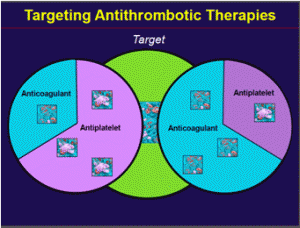A history of bleeding has
been reported as a risk factor for subsequent bleeding, but this
observation has not been consistent. A history of nonbleeding
peptic ulcer disease, however, has not been associated
with subsequent GI bleeding. 
Other comorbid diseases have been associated with bleeding during warfarin therapy; these include treated hypertension, cerebrovascular disease, ischemic stroke, serious heart disease, and renal insuf- ficiency. The presence of malignancy was a significant predictor of major bleeding in several stud-ies. In two of these studies, overanticoagulation was not the explanation for an increased risk of bleeding, whereas in one study, the severity of the cancer was identified as a risk factor. Another study did not confirm that malignancy predisposed to bleeding, while others excluded patients with malignancies.
Although many other patient characteristics have been associated with bleeding during warfarin therapy, the data supporting these findings are not compelling. For example, some studies noted an increased frequency of bleeding among women treated with warfarin, but others have not. Although most experienced clinicians believe that either alcoholism or liver disease increases the risk of bleeding during long-term warfarin therapy, two studies did not find such an association, whereas a large population-based study did.
Occult pathologic lesions may also precipitate warfarin-related bleeding. In one study, 73% of adequately evaluated patients with a prothrombin time ratio < 1.5 at the time of bleeding had an underlying pathologic lesion, compared to 16% of patients with a prothrombin time ratio > 1.5 (p < 0.05). However, pathologic lesions were found to be associated with GI or genitourinary bleeding in 30% of patients with prothrombin time ratio > 2.5.
Concomitant drugs
Concomitant use of aspirin has been associated with a higher frequency of bleeding, even in patients treated with warfarin therapy with a mean INR of 1.5. In a large randomized trial comparing the combination of low-dose warfarin therapy and aspirin, 80 mg/d, to aspirin, 160 mg/d, in patients with a history of myocardial infarction, the frequency of spontaneous major hemorrhage during the first year of therapy was increased to 1.4% in patients treated with 3 mg of warfarin (INR < 2.0) and aspirin, 80 mg/d, compared with 0.7% in patients treated with aspirin, 160 mg/d (p = 0.01). In a large trial of primary prevention in persons at high risk for ischemic heart disease, the rate of hemorrhagic stroke was 0.09%/yr in those treated with low-dose warfarin (target INR 1.5) plus aspirin, 75 mg/d, 0.01%/yr with low-dose warfarin alone, and 0.02%/yr with aspirin, and none in the placebo group.
Canadian Health Care Legal Pharmacy – www.acanadianhealthcaremall.com.